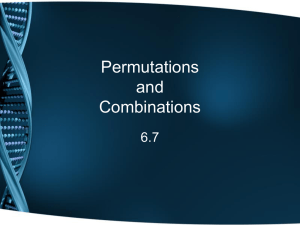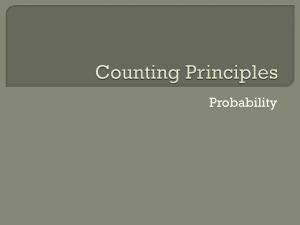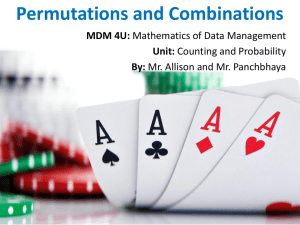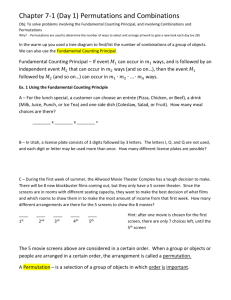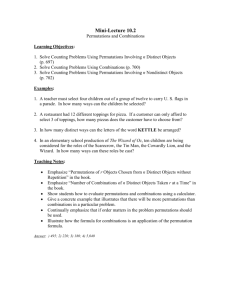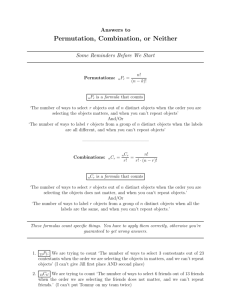6.6. Combinations and permutations. Simple counting problems
advertisement
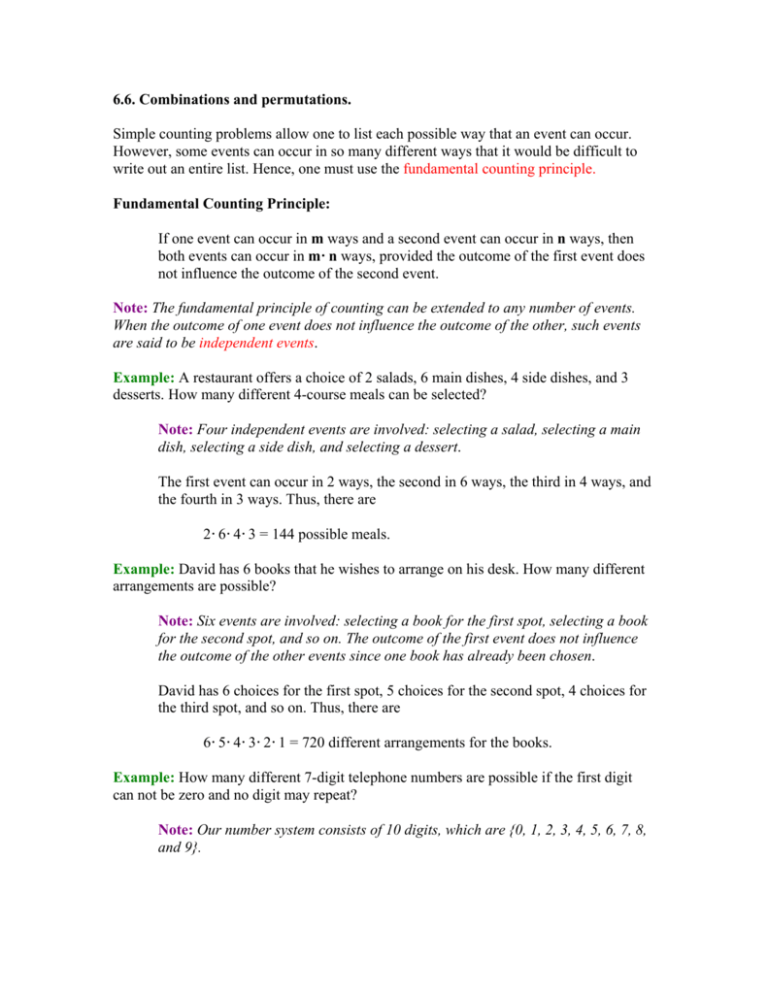
6.6. Combinations and permutations.
Simple counting problems allow one to list each possible way that an event can occur.
However, some events can occur in so many different ways that it would be difficult to
write out an entire list. Hence, one must use the fundamental counting principle.
Fundamental Counting Principle:
If one event can occur in m ways and a second event can occur in n ways, then
both events can occur in m· n ways, provided the outcome of the first event does
not influence the outcome of the second event.
Note: The fundamental principle of counting can be extended to any number of events.
When the outcome of one event does not influence the outcome of the other, such events
are said to be independent events.
Example: A restaurant offers a choice of 2 salads, 6 main dishes, 4 side dishes, and 3
desserts. How many different 4-course meals can be selected?
Note: Four independent events are involved: selecting a salad, selecting a main
dish, selecting a side dish, and selecting a dessert.
The first event can occur in 2 ways, the second in 6 ways, the third in 4 ways, and
the fourth in 3 ways. Thus, there are
2· 6· 4· 3 = 144 possible meals.
Example: David has 6 books that he wishes to arrange on his desk. How many different
arrangements are possible?
Note: Six events are involved: selecting a book for the first spot, selecting a book
for the second spot, and so on. The outcome of the first event does not influence
the outcome of the other events since one book has already been chosen.
David has 6 choices for the first spot, 5 choices for the second spot, 4 choices for
the third spot, and so on. Thus, there are
6· 5· 4· 3· 2· 1 = 720 different arrangements for the books.
Example: How many different 7-digit telephone numbers are possible if the first digit
can not be zero and no digit may repeat?
Note: Our number system consists of 10 digits, which are {0, 1, 2, 3, 4, 5, 6, 7, 8,
and 9}.
Since the first digit can not be a zero, then there are 9 choices for the first digit, 9
choices for the second digit since a zero can be used and no digits may repeat, 8
choices for the third digit, 7 choices for the fourth digit, and so on. Thus, there are
9· 9· 8· 7· 6· 5· 4 =544,320 possible telephone numbers.
The number of ways that n elements can be arranged in order is called a permutation of
the elements.
Permutations of n Elements r at a Time
If P(n, r) denotes the number of permutations of n elements taken r at a time with
r ≤ n, then
Some other symbols used for permutations of n things taken r at a time are
nPr.
Clue Words: Arrangement, Schedule, Order
Example: Suppose that 7 people enter a swim meet. Assuming that there are no ties, in
how many ways could the gold, silver, and bronze medals be awarded?
Note: Since awards are to be made, order is important. Thus, this would be
treated as a permutation.
There are 210 ways that the medals could be awarded.
Example: In how many ways can 6 students be seated in a row of 6 desks?
Note: This is a permutation because order is important. That is, a student may
wish to sit in a particular seat or behind/in front of a particular student.
There are 720 ways the students could be seated.
Note: Most calculators have a key for permutations.
When the arrangement or order of the elements is not important this is called a
combination of the elements.
Combinations of n Elements r at a Time
If
represents the number of combinations of n elements taken r at a time
with r ≤ n, then
Other symbols used for combinations of n things taken r at a time are C(n, r), nCr.
Clue Words: Group, Committee, Sample
Example: How many different committees of 3 people can be chosen to work on a
special project from a group of 7 people?
Note: Since the order in which the members of the committee are chosen does not
affect the result, this is a combination.
There are 35 ways to select the project group.
Example: In how many different ways can a group of 3 people out of a group of 7 people
be chosen to work on a project if it has already been decided that a certain person must
work on the project?
Note: This is still a combination but the problem has been reduced to selecting 2
more people from the remaining 6 people.
There are 15 ways to select the project group.
Note: Most calculators have a key for combinations.

